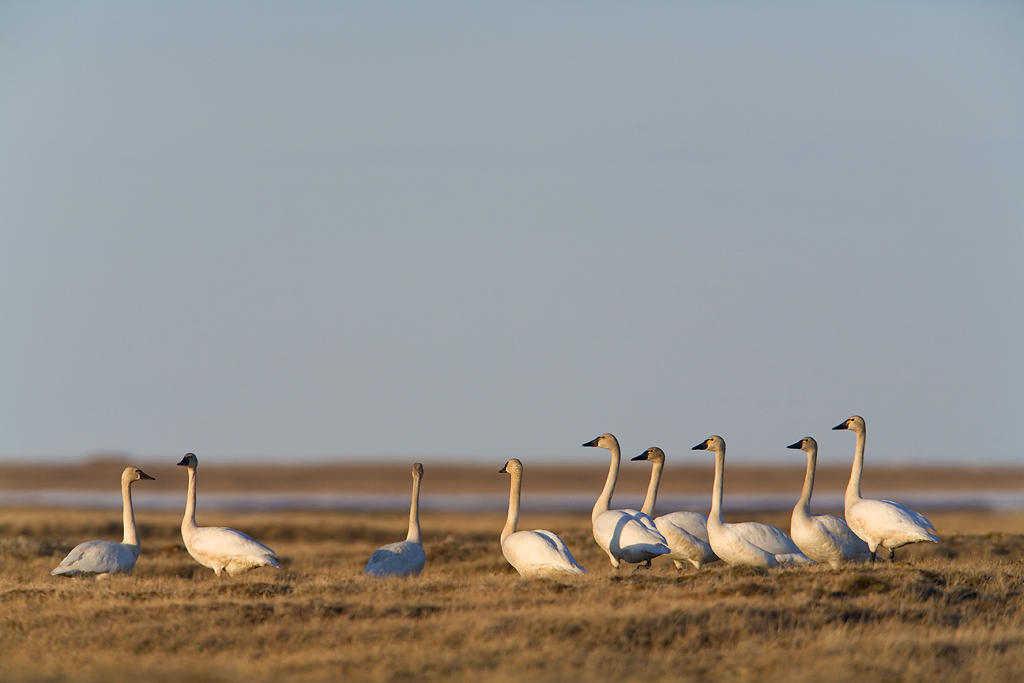By Susan Culliney
For many Americans, the Arctic National Wildlife Refuge brings to mind roaming polar bears, frolicking caribou, migratory birds, and tundra wildflowers. The Arctic Coastal Plain, in particular, is a vibrant ecosystem like nowhere else on earth. It is a place where many flyways converge. Birds, from the mighty Tundra Swan, to the diminutive Semipalmated Sandpiper, nest in the Coastal Plain and then make epic migratory journeys to their wintering grounds in backyards and birding spots across the United States and all over the world.
In addition to this vivid imagery, mention of the Arctic National Wildlife Refuge also brings to mind a decades-long battle over whether to drill in this pristine corner of Alaska. The new political landscape brings this frightening possibility closer than ever before. As things stand today, the clearest threat to the Refuge comes in the form of the congressional budget reconciliation process.
The Arctic National Wildlife Refuge is currently protected by a landmark conservation law, the Alaska National Interest Lands Conservation Act (ANILCA). This 1980 statute prohibits any drilling in the Refuge (including the Coastal Plain) without further legislative action by Congress.
Every single year since the passage of ANILCA, certain members of Congress have introduced bills to make drilling in the Arctic National Wildlife Refuge a reality. On the eve of last fall’s Presidential election, Alaska Senator Murkowski vowed to open the Refuge to drilling. But due to the filibuster remaining in the Senate, the clearest pathway to opening the Refuge lies with budget reconciliation, which only requires 50 votes rather than the threshold of 60 votes required by the filibuster.
The budget reconciliation process represents an imminent threat to the Arctic National Wildlife Refuge. Congress is presently trying to use the Fiscal Year 2017 budget reconciliation process to repeal and replace the Affordable Care Act, a tactic proving both messy and divisive. Once Congress is able to settle the FY17 process, the FY18 process will soon follow, with best estimates that it will begin in earnest this summer or fall. Many fear that the 2018 process will again be bitter and messy, this time bogged down by a wide array of issues, potentially including drilling in the Refuge.
Fortunately, the conservation of birds and land are not partisan issues. Americans from diverse walks of life, and of all political stripes, truly cherish our nation’s birds and public lands, including Arctic birds and the Arctic National Wildlife Refuge. In the absence of public lands leadership from Congress and the Administration, Audubon Alaska is working with the Audubon network around the country to gain critical bipartisan support for protecting the Arctic Refuge.
Together we can encourage members of Congress, both past champions and emerging leaders, to stand up for the Arctic. Constituents like you enjoy knowing that a particular Tundra Swan, or shorebird, or duck you see in your backyard may very well have rubbed wingtips with the musk oxen and polar bears on the Arctic Coastal Plain. Let your Senators and Representatives know how much you care about the Arctic National Wildlife Refuge. Reach out to them by taking action, or by writing a letter to the editor of your local paper explaining what Arctic birds mean to you, and why the Refuge should not be a part of any legislation, and certainly not a part of the budget process. It really does make a difference!
Don’t forget to let us know what actions you take on behalf of the Refuge. We’d love to publicize and amplify your efforts. Email egustafson@audubon.org.





